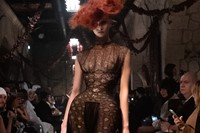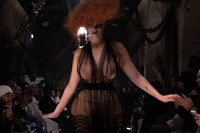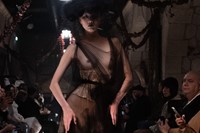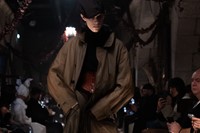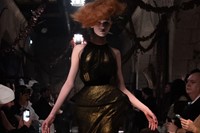Now. There are fashion shows, and there are fashion shows. John Galliano is undoubtedly the master of the latter, of embedding his clothes in a core narrative whose devious complexity isn’t a distraction from the craft on display but rather grist to the mill and fuel to the fire. Does this woman live by gaslight or candlelight is a question Galliano will ask himself – and it matters, because the nuance of that light affects the colour of the red dress she’s wearing, how its surface may look and react in his retelling of her stories, her life. So his shows aren’t just set-dressing, but rather inherent elements to and reflections of a creative process that has produced, in my opinion, some of the greatest clothes of the past half-century.
On Thursday evening, John Galliano took over the left bank underbelly of the Pont Alexandre III in Paris for his Maison Margiela Spring/Summer 2024 Artisanal show, recreating a 1920s dive bar complete with ramshackle bentwood chairs, sickly, violet-flavoured cocktails and cloudy, mercury-backed mirrors in peeling gilt frames. It was lit by the light of the first full moon of the year. Meaning, much? He then peopled it with characters drawn from the voyeuristic work of Brassaï, their stilted movements recalling jointed marionettes or, perhaps, the jerking motion of early cinema, where the moving image was a marvel as opposed to an iPhone-recorded everyday occurrence. And how about going back to when fashion itself was a marvel, when you gasped and dreamed and waited with baited breath to see what fantasies fashion designers could conjure up, to make us all dream?
That was here, in this collection, in spades. While the setting was extraordinary and the models – their bodies re-engineered with prostheses and corsetry and Dame Pat McGrath’s unbelievable make-up artistry – were emoting with all their might, the focus was still entirely on the clothes. Because they were unbelievable, a cavalcade of technique and experimentation and creative expression, keyed perfectly with the place and the near-inhuman bodies they were shown on. The models – or muses, as Galliano rightfully calls them these days – wound up melding with the clothes, literally in a sequence of body-smothering pieces inspired by the Fauvist artist Kees van Dongen, who saw bodies in blue and skies in pink and green, and painted a fantasy world unlike that we mere mortals see. A kindred spirit, then, to Galliano.
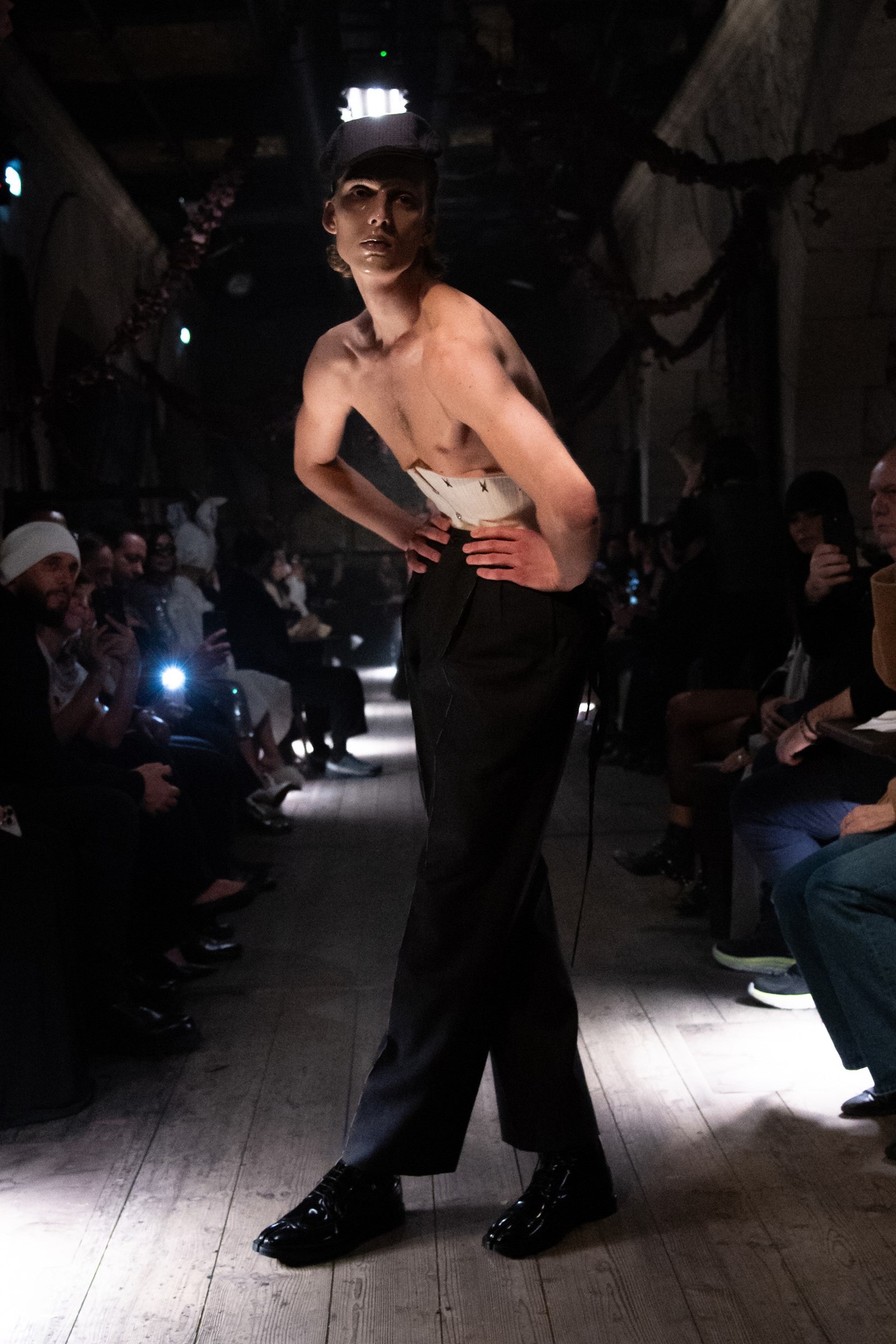
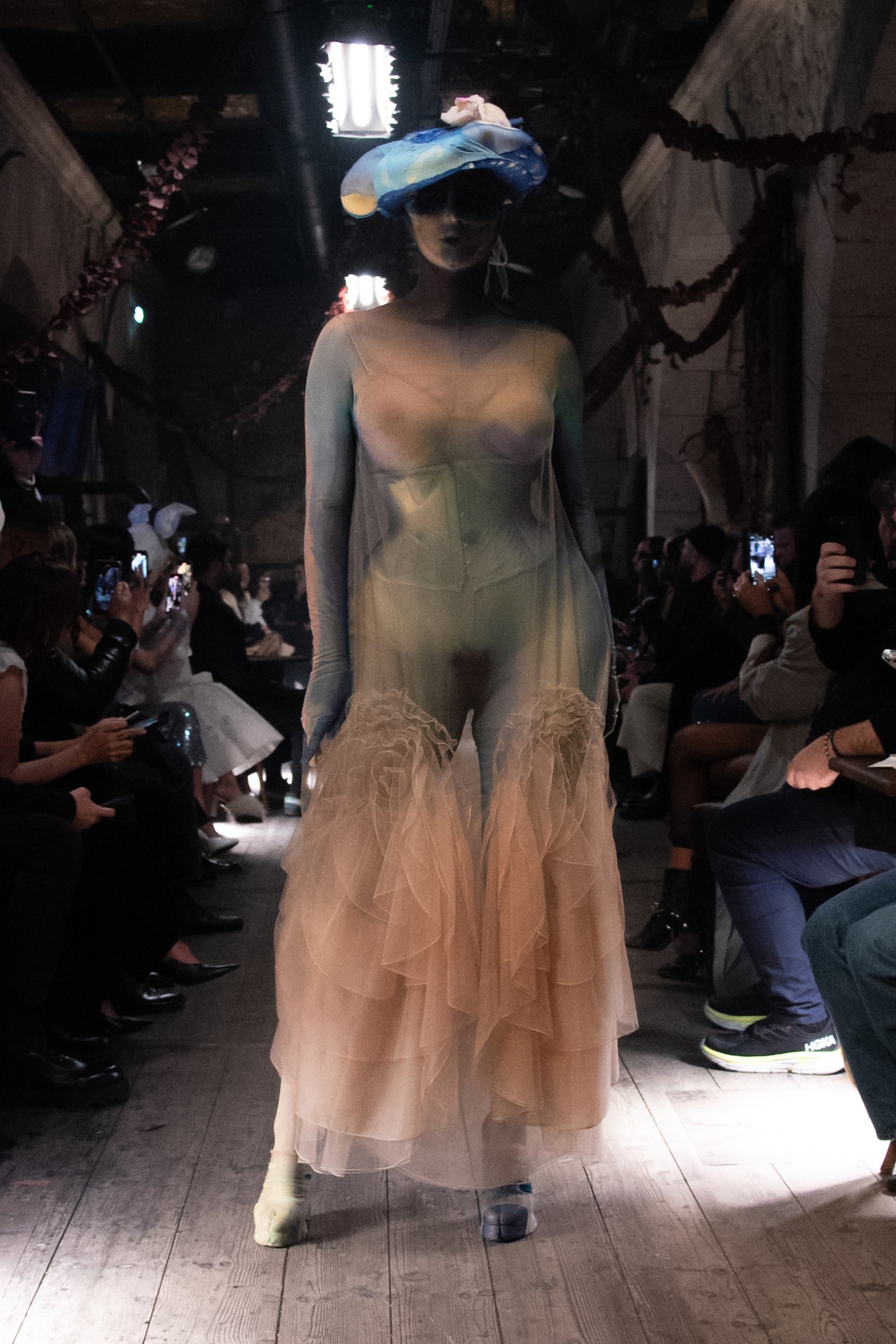
And the clothes. The clothes! Unreal bodies, fabric made flesh, with the cinched waists of Belle Époque grandees and the padded cocotte silhouettes of Christian Dior’s midcentury couture, for him and for her. Yes, there were echoes of Galliano’s own stories past – his work at Dior, for sure. When a tissue-lamé dress in gold veiled with tulle passed by, the model’s head topped with an Alphonse Mucha pompadour of auburn hair, I couldn’t help but see Suzanne von Aichinger, Galliano’s glorious house model of the late 1990s, dressed like a Boldini painting in a custom-built conservatory in the Parc de Bagatelle. And the padded suits reminded me of Yasmeen Ghauri in October 1994, in a padded and pinched houndstooth suit, a show dedicated to Misia Sert, whose ghost roamed the floorboards of this show as well. And it made me think back a bit further, to March of that same year, where, in a disused mansion in the 6th arrondissement, filled with leaves and fallen chandeliers, Galliano showed a handful of black dresses to a smattering of fashion press and changed the way women dressed. You had the sense again, here, that something spectacular was happening. It was that much-mythologised ‘fashion moment’.
But the São Schlumberger show – as that show became known, staged as it was in that late, great haute couture patroness’s manor – was pulled together last-minute, on a shoestring. Here, Galliano’s pieces were expressive of the greatest luxury of all: time. Pieces 12 months in thought and nine months in the physical making, constructed from scraps of lace or pieces of tulle to give the affect of light falling across cloth, or water and oil stains. These are also techniques Galliano has experimented with across his Margiela tenure – he celebrates a decade here this year.
This show was indeed a celebration. A celebration of humanity, of individuality, of fashion as pure creative expression and of extraordinary craft. They don’t call it ‘Artisanal’ for nothing – here, technique was pushed to a new zenith. Summarising the different approaches and inventions and experimentations in this collection would take forever, but suffice to say they managed to meld old-school and high-tech, in an extraordinary expansion of what couture can mean. There were silicone treatments to make fabrics seem soaked, dragged through water or rained on; tweeds were treated with glue and crêpe then boiled to shrink and mould the material. Coats were made from layers of organzas and chiffons printed to resemble heavy-duty wools, then smothered in tulle. Lace dresses were decoupaged, to appear apparently seamless. In short, nothing was as it appeared – including ‘porcelain’ neck-pieces, actually made from polished leather. It was an astonishing, extraordinary, you-need-to-be-there-to-believe-it moment of fashion trickery.
And what a justification for the continuing relevance of haute couture, for its unique power and abilities. You could extract these Galliano clothes entirely from their setting, plonk them down in an antiseptic white box, and they still would have been unbelievable feats of design. Within this context, however, they became something else – something greater and grander, something transportive. Galliano at his very best has that rare gift – his shows are fantasies, where, rather than being a passive observer, the audience becomes embedded in the action, active participants in their own fever-dream. Smelling the air, sensing the fabric, feeling everything. The clothes are the tangible, achievable take-home from the experience – like an aide-mémoire, or maybe a postcard. Less ‘Wish You Were Here’, more ‘Wish We Were Still There’. The audience roared their approval, stamped their feet, begged for more.
Maybe time isn’t the ultimate luxury. Perhaps that accolade belongs to talent. Imagine having the mind to think this stuff up, to move people like this? Imagine being able to do this. What a luxury. And what a luxury to witness it, at full throttle and in full glory. It will change fashion.


